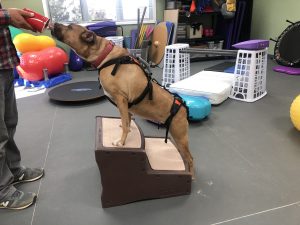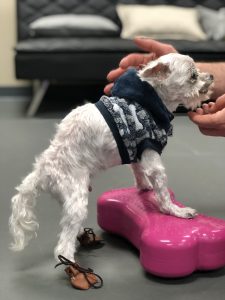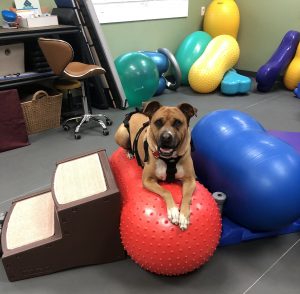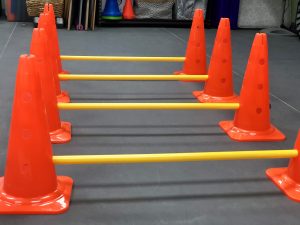WHAT DOES REHAB LOOK LIKE FOR MY DOG?
Tracie Grubb, DVM, CCRT, cVMA
HAVE YOU EVER HAD YOUR OWN PHYSICAL THERAPY?
If you are lucky, you have never had surgery or a serious injury warranting physical therapy. But, let’s be real… most of us have had one or both.
If you injure your back, knee, shoulder, or other body part, you’ve likely been prescribed physical therapy by your doctor. This prescription should help with pain, strength, balance, flexibility, and general movement and life quality. No one wants to be sidelined due to injury or pain.
Animals are no different. For years we simply advised pet owners to put their recovering/inured furry companion in a crate to “rest” while they healed. It’s not surprising that we saw a smaller, weaker animal come out of the cage from sheer muscle atrophy.
But times, they have changed! Luckily for our beloved pets, we now promote structured, controlled movements and exercises to do the same things our physical therapists do to help us. Veterinary physical therapy is called “Rehabilitation,” or “Rehab,” for short.
This article addresses canine rehab, but rest assured that rehab for all species is an option depending on the therapist.
GOALS:
♥Pain Management
First and foremost, get rid of the pain! How do we do this? We work closely with your family veterinarian to determine if additional or alternative medications/supplements are needed. We may also use modalities such as:
- massage techniques
- joint mobilization
- photobiomodulation therapy (laser)

- acupuncture
- veterinary medical manipulation (chiropractic adjustments)
- extracorporeal shockwave
- pulsing electromagnetic field therapy
- hyperbaric chamber use
- joint injections
- hydrotherapy
…just to name a few
♥Therapeutic Exercise (Ther-Ex)
Ther-Ex may range from stretches to warm up muscles and surrounding tissues (nerves, ligaments, tendons) to retraining muscles to function normally. Exercises are focused to target specific muscle

groups that surround the injured area to stabilize a joint. We may also use exercise to gently work a weak , underused muscle directly.
OW OFTEN DOES MY DOG NEED TREATMENT?
Each case is different, therefore, each plan is customized. Some animals may need frequent sessions (1 or more per week); some may benefit from treatment every 2-4 weeks.
Senior pets may require rehab for a longer duration than younger pets. Pets with advanced orthopedic, neurological, degenerative conditions tend to require longer treatment periods than those recovering from common surgeries. Your rehab therapist will guide your treatments accordingly.
HOME EXERCISE PLANS:
You’ve heard the phrase, “You get out of it what you put in to it.” Well, it’s living proof with rehab. Your pet will be prescribed home exercises to be done at prescribed intervals. These generally take just a few minutes 1 to 3 times daily or every other day. It is important that the plan be followed for best results. Any problems should be immediately brought to the attention of your therapist so that modification can be made.
When your pet is ready to graduate from rehab, you should feel comfortable that the exercises leading up to this point have positioned your pet well to return to a full, fun life.



